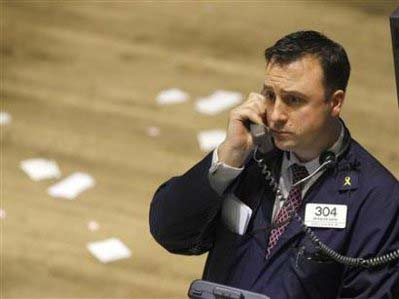Updated: 2008-11-14
(China Daily) NEW YORK – Wall Street launched a massive rebound Thursday, muscling the Dow Jones industrial average up nearly 553 points after driving it down near its lows for the year, as investors decided they did not want to miss out on cheap stocks.
After three days of selling that wiped out about $1 trillion in shareholder value, many investors, though nervous about the economy, appeared convinced the market had priced in enough bad news. So when the Standard & Poor's 500 index managed to recover from multiyear trading lows, investors swarmed back in.
|
|
It's "a herd mentality," said Ryan Larson, senior equity trader at Voyageur Asset Management. "We started going higher, and you don't want to be the last one on the boat."
Some analysts also said investors were positioning themselves ahead of a meeting of Group of 20 leaders in Washington. The meeting could bring decisions on mending the troubled global financial system.
There was "some anticipation that we'll hear some good news from that meeting," said Jack A. Ablin, chief investment officer at Harris Private Bank. Thursday's rally was "part hopeful, part technical. But certainly welcome."
As stocks rallied, so did oil prices, sending shares of energy companies higher. The biggest gainer among the 30 Dow companies was Chevron Corp., which rose $8.43, or 12.5 percent, to $75.71. Another big gainer was Exxon Mobil Corp., which climbed $6.48, or 9.4 percent, to $75.41; these two energy stocks represented one-fifth of the Dow's point gain Thursday.
Stocks sold off early after the Labor Department said the number of newly laid-off individuals seeking unemployment benefits jumped last week to the highest level since right after the Sept. 11, 2001 terrorist attacks. There was also more evidence of a severe pullback in consumer spending, a worsening trend that had pummeled stocks earlier in the week. Wal-Mart Stores Inc. trimmed expectations for full-year earnings, and Intel Corp. late Wednesday cut more than $1 billion from its sales forecast.
But then the S&P lifted above its Oct. 10 trading lows, and a Treasury auction of 30-year bonds got decent demand from both domestic and foreign buyers, said Arthur Hogan, chief market analyst at Jefferies & Co. The auction results alleviated some fears about the government having a hard time financing its costly bailout.
Many analysts had predicted the market would retest the multiyear lows it reached last month. They also still forecast volatility for some time to come, as Wall Street tries to rebuild from October's devastating losses and gauge the severity of the economy's downturn. During past recoveries from bear markets, a great deal of turbulence in the market became commonplace, so it's possible that Thursday's gains will get erased if more gloomy reports pour in.
But Hogan called the market's resiliency a "great sign."
According to preliminary calculations, the Dow rose 552.59, or 6.67 percent, to 8,835.25, after falling as low as 7,965.42 and rising as high as 8,876.59. That's a trading range of 911 points. The Dow did not sink below its Oct. 10 trading low of 7,882.51.
The Dow's nearly 553-point gain was the third-largest single-session point gain on record, following the 889-point rise on Oct. 28 and the 936-point surge on Oct. 13.
The Standard & Poor's 500 index rose 58.99, or 6.92 percent, to 911.29, after dropping to 818.69, well below its intraday low of 839.80 on Oct. 10.
The Nasdaq composite index rose 97.49, or 6.50 percent, to 1,596.70.
The Russell 2000 index of smaller companies rose 38.43, or 8.5 percent, to 491.23.
The stock market gained back $700 billion Thursday, after losing about $1 trillion during the first three days of the week, according to the Dow Jones Wilshire 5000 index, which reflects the value of nearly all U.S. stocks. At its lowest trading level Thursday, the market value of the Wilshire index fell below $10 trillion for the first time since April 2003.
Advancing issues outpaced decliners by nearly 3 to 1 on the New York Stock Exchange, where volume came to 1.99 billion shares.
The price of a barrel of light, sweet crude rose $2.08 to $58.24 on the New York Mercantile Exchange, after falling to the lowest levels since January 2007.
Government bond prices fell as investors fled back into stocks. The three-month Treasury bill's yield rose to 0.20 percent from 0.13 percent late Wednesday, and the yield on the benchmark 10-year Treasury note rose to 3.88 percent from 3.67 percent late Wednesday. Higher yields indicate lower demand.
Wal-Mart shares rebounded $2.31, or 4.4 percent, to $54.93. The discount retailer's shares had traded lower in earlier trading after it cut its profit outlook because of the flagging global economy and renewed strength of the dollar. Wal-Mart is the only company among the Dow industrials that is up for the year.
Intel also slashed its outlook, initially driving down shares on concerns that consumers are shying away from big purchases like computers. But its shares recovered to trade up 91 cents, or 6.7 percent, to $14.43.
General Motors shares, however, remained weak as the nation's automakers wait for President-elect Obama to push Congress to approve a bailout of the struggling industry. There are also reports that Obama will move to appoint a czar or board to oversee the companies. GM dropped 13 cents, or 4.2 percent, to $2.95. Ford shares rose 6 cents, or 3.3 percent, to $1.90.
The dollar was mixed against other major currencies. Gold prices rose.
Overseas, Japan's Nikkei closed down 5.25 percent and Hong Kong Hang Seng fell 5.15 percent. In European trading, Britain's FTSE 100 was down 0.31 percent, Germany's DAX rose 0.62 percent, and France's CAC-40 added 1.10 percent.









No comments:
Post a Comment